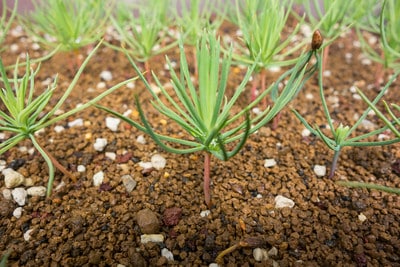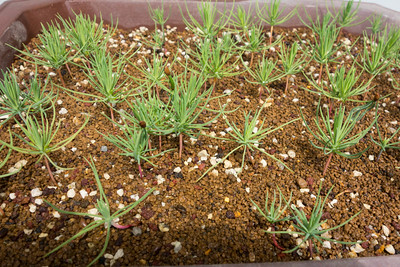I started my first batch of black pine bonsai from seed over 20 years ago. Most of these trees have been developed using the seedling-cutting technique. This year, I’m foregoing the technique and letting the seedlings grow freely for a change.

Black pine seedling – July 2014
Striking cuttings from seedlings can simplify the process of producing even root growth. This year I’m aiming to produce trees with uneven root growth. The idea is that natural root growth guided by selective pruning during repotting can also produce great surface roots. As I’ve often worked with seedling-cuttings, I’m looking forward to learning what differences, if any, working with non-seedling cuttings entails.

Black pine seedlings
The inspiration for letting the young trees grow freely this year? My visit to Miyakonojou this past winter. During this visit, I found evidence that great trees can be produced without the technique. I’ll let you know how it goes!
Subscribe to Bonsai Tonight
New Posts Delivered Every Tuesday and Friday
mirko says
To do pine trees with exposed roots as you think you do?
shahinisengupta says
useful piece of info. thnx for sharing 🙂
Dick van Dreven says
Dear Jonas,
A couple of years ago I tried the seedling-cutting methode on my black pine seedlings. Living in the Netherlands I found that our growing season is barely long enough to establish good growth on te cuttngs the first year.
One year later I didn’t make cuttings of the black pine seedlings. These are now in their second year and allmost as developped as the seedling cuttings that are one year older!
And it stil will be possible to get an excellent nebari by pruning roots and growing in pond baskets.
Adam says
I was actually thinking if trying this, and then using a tourniquet on the tap roots after letting them grow for a few years. I used this method with an oak sprouted from an acorn, and got some good results (accelerated thickening of the trunk, and nice taper). Something you might want try experimenting with.
bonsaibible says
This seems very interesting, I’m quite curious to see how this will turn out 🙂
L. Rolyat says
I have enjoyed browsing through your blog – I particularly enjoyed the Sierra juniper posts (couldn’t comment there because comments are closed). We have a tree here called a water berry (Syzygium species) which grows on the banks of the Zambezi River. The constant action by the rising and falling water level creates the most beautiful root and branch contortions – I would love to try to recreate this with a bonsai.
Jonas Dupuich says
Thanks for the note – it’d be great to see more syzygium bonsai!